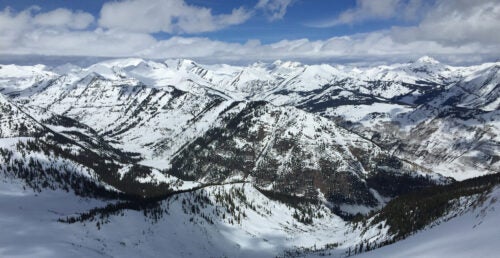
Boise State will receive two grants from the U.S. Department of Energy to support research on issues significant to our region and the western United States including water, food, energy use and production in the face of changing environmental conditions.
Perhaps as significant, said Alejandro Flores, an associate professor in the Department of Geosciences, the grants will help Boise State join forces with researchers at other federal research facilities and universities addressing other facets of these scientific challenges.
“In some sense, these grants allow us to become part of this much larger team,” said Flores. “It’s an amazing group of researchers, and Boise State is now a part of it.”
The first grant, $200,000 over a two-year period, is a “subaward,” part of an ongoing DOE Scientific Focus Area, the Integrated Multi-sector, Multi-scale Modeling (IM3) Scientific Focus Area led by the DOE’s Pacific Northwest National Laboratory in Richland, Washington. Flores, working with Kendra Kaiser, a post-doctoral research assistant in geosciences and Vicken Hillis, an assistant professor in Human-Environment Systems in the College of Innovation and Design, will study the Snake River Basin and Snake River Plain. Their aim is to determine how land use will evolve in response to climate change in ways that include an array of “on the ground” decisions. This could include the crops farmers choose to plant in response to both global market forces and whether they have (or can acquire) enough water to irrigate them.
“We’re trying to determine how the decisions made at a local level lead to regional patterns in land use.” said Flores. “The idea is to understand and reconcile how those regional patterns that arise from local decision-making square with global-scale demands for goods and services produced within the same area. We want to determine where there might be conflicts when it comes to issues like water use, and food and energy production.”
The IM3 partnership is also an example of how national labs and universities can work together to address important scientific challenges that require many different kinds of expertise and capabilities, said Ian Kraucunus, leader of the IM3 project and division director for PNNL’s Atmospheric Sciences and Global Change Division.
“We are excited to bring the Boise State team onto the project, because they bring a unique set of skills that can help us bridge the gap between large-scale projections of land use change and on-the-ground decision making,” said Kraucunus.
The IM3 project includes other DOE national labs, including the Sandia National Laboratories and the National Renewable Energy Laboratory, the National Center for Atmospheric Research, as well as universities that include the Colorado School of Mines, Lehigh University, and Montana State University.
The second grant, $400,000 over a two-year period, is from the DOE Office of Science Subsurface Biogeochemical Research program. Boise State researchers will use regional models and satellite data to quantify how snow water storage in the Colorado Rockies has varied in space and time over past decades.
“This project will see us partner with the Watershed Function Scientific Focus Area, said Flores, “this one led by Lawrence Berkeley National Lab, seeking to build better models to predict how watersheds store, retain, and release water and nutrients.”
Flores said the goal is to build better models for the future that could be applied in other mountainous regions, sometimes referred to as the “water towers of the world.”
These models are needed to predict how mountain regions will respond to future disturbances like drought, fire, and land use change, he said.
Susan Hubbard, who leads the Watershed Function Scientific Focus Area, said Flores’ new project is “expected to lead to insights about how snowpack dynamics influence the hydrologic behavior of headwater systems in the Upper Colorado basin, as well as a new class of new model-data assimilation approaches that should be generally useful at watersheds both throughout the Rocky Mountains and worldwide.”
In addition to the Lawrence Berkeley Lab, Boise State will collaborate with staff from the Desert Research Institute and scientists from the University of Utah, the University of Colorado at Boulder, NCAR, CSM, and Stanford University who already are engaged in the project.